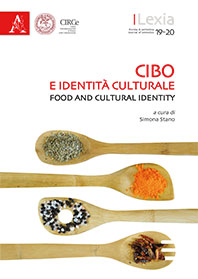Estratto da
LEXIA. RIVISTA DI SEMIOTICA
Cibo e identità culturale | Food and Cultural Identity
Il cibo e la commensalità nella prospettiva del Gesù storico
LEXIA. RIVISTA DI SEMIOTICA
Cibo e identità culturale | Food and Cultural Identity
Il cibo e la commensalità nella prospettiva del Gesù storico

ENGLISH TITLE: Food and Commensality in the Life of the Historical Jesus
ABSTRACT: Food and commensality are a fundamental part of the texts that recount the life and works of Jesus and the birth of Christianity. Commensality is Jesus’ preferred method of transmitting his message and through the parables he presents open and inclusive banquets, in line with his plan for a society based on equality. But can the commensality described in the Gospels be traced back to the historical Jesus, or should it rather be attributed to the Jesus who has been “remodelled” by the evangelists, who were writing after 70/80 CE and needed to instruct the first Christian communities living in Hellenistic settings? It is well–known that the Gospels are stratified texts in which the problems presented by the historical Jesus have been overlaid with the topics debated by the early Christian communities. From a semiotic point of view, underlying accounts of commensality is the semantic category “inclusion” vs. “exclusion”; but while for the historical Jesus social inclusion was paramount, for the early communities “exclusion” (or selection) based on ethical–behavioural principles was also important. This difference in approach to what is valuable means that the actantial model has to be redefined, in particular the competence of the Subject (humanity) who has to attain salvation (performance).
KEYWORDS: semiotics of religion; historical Jesus; food; commensality; text analysis.
ABSTRACT: Food and commensality are a fundamental part of the texts that recount the life and works of Jesus and the birth of Christianity. Commensality is Jesus’ preferred method of transmitting his message and through the parables he presents open and inclusive banquets, in line with his plan for a society based on equality. But can the commensality described in the Gospels be traced back to the historical Jesus, or should it rather be attributed to the Jesus who has been “remodelled” by the evangelists, who were writing after 70/80 CE and needed to instruct the first Christian communities living in Hellenistic settings? It is well–known that the Gospels are stratified texts in which the problems presented by the historical Jesus have been overlaid with the topics debated by the early Christian communities. From a semiotic point of view, underlying accounts of commensality is the semantic category “inclusion” vs. “exclusion”; but while for the historical Jesus social inclusion was paramount, for the early communities “exclusion” (or selection) based on ethical–behavioural principles was also important. This difference in approach to what is valuable means that the actantial model has to be redefined, in particular the competence of the Subject (humanity) who has to attain salvation (performance).
KEYWORDS: semiotics of religion; historical Jesus; food; commensality; text analysis.
| pagine: | 233-246 |
| DOI: | 10.4399/978885488571415 |
| data pubblicazione: | Giugno 2015 |
| editore: | Aracne |








